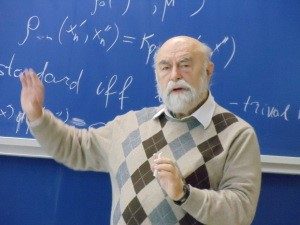Beijing-Saint Petersburg Mathematics Colloquium (online)
Abstract
1. Admissible metrics on the measure space: new trend in the theory of mm spaces.
2. Classification of mm-spaces. Matrix distributions.
3.Thе actions of measure preserving groups in the space of admissible metrics in measure space. ($\ca M \subset L^1(X\otimes X, \mu \otimes \mu).
4.Average metrics, ergodic limit and asymptotic invariants,
5.Sclaing entropy. Scaling entropy function. Examples.
6.Theorem. Bounded scaling entropy and discrete spectra. Sequential entropy by Kushnirenko. All possible scalings.
7.New geometrical problems.
Bio

Prof. Vershik is the Head of the Laboratory of Representation Theory and Dynamical Systems at Saint Petersburg Department of Steklov Mathematical Institute and professor at Saint Petersburg State University. He was President of the Saint Petersburg Society from 1998 to 2008. He is a member of European Academy of Sciences (since 2015), he was a member of Executive Committee of European Mathematical Society (1996-2000), Laureate of Humboldt Research Award - 2007 and an ICM invited speaker (1974 and 1994), Miller-professor (Berkeley, 1995) and Simons-professor (MSRI, 2008). His research interests include but are not limited to
- infinite-dimensional groups and their Asymptotic Representation Theory;
- Lie groups;
- New methods of Representation Theory for finite symmetric groups;
- Combinatorial Probability Theory and limit forms for configurations (the Vershik-Kerov theorem on limit forms of Young diagrams, Bratelli-Vershik diagrams, etc) ;
- Universal objects in Combinatorics Geometry and Dynamical Systems;
- Dynamical Systems and Ergodic Theory;
- Non-holonomic Geometry and Mechanics;
- Random processes, random walks and random matrices;
- Optimization.